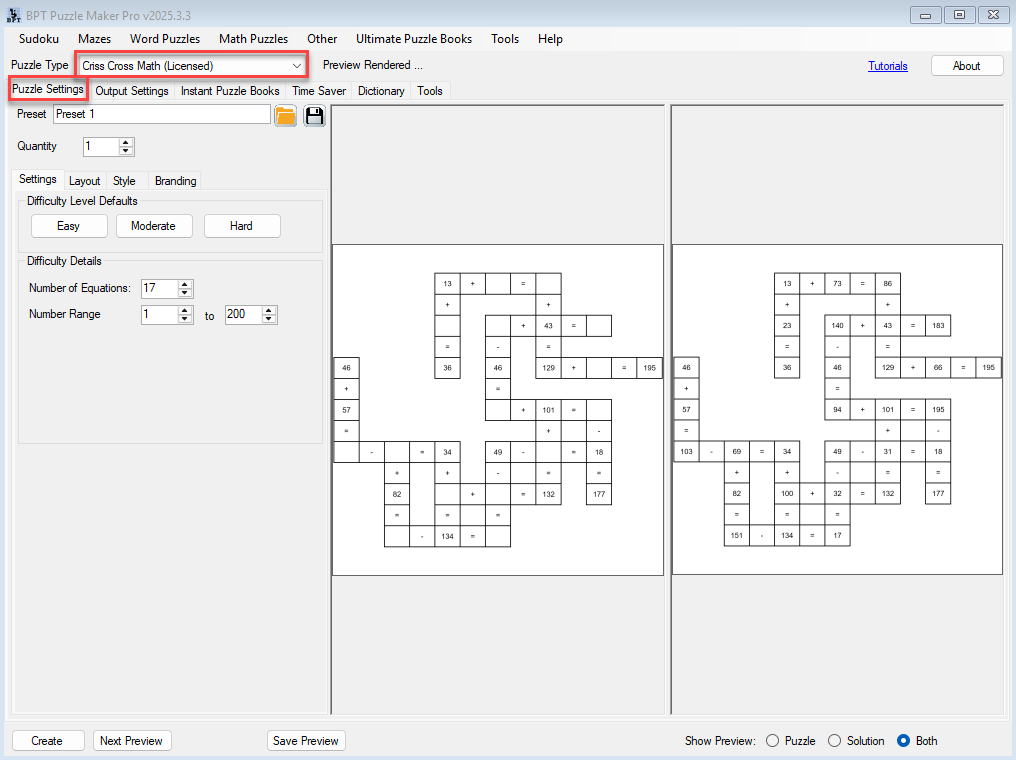📚 Setting Number Range and Operators – Control Puzzle Difficulty
1. What This Tutorial Covers
Learn how to set the number range and understand how Puzzle Maker Pro – Criss Cross Math handles operators to control puzzle difficulty.
This tutorial applies to:
Puzzle Maker Pro – Criss Cross Math
2. Introduction
Why Adjust Number Range?
Controlling the number range allows you to tailor puzzles for different age groups and skill levels. Smaller values help younger learners; larger ranges offer more challenge.
What You’ll Learn
By the end of this tutorial, you’ll know how to:
- Define number range values
- Understand how operators are applied
- Adjust puzzle complexity quickly and easily
3. First-Time Setup (For New Users)
Getting Started
- Launch Puzzle Maker Pro – Criss Cross Math
- Navigate to the Settings tab to access Number Range and Operators options

4. Setting Number Range and Operators
Step 1: Operators (Currently Addition and Subtraction)
- At this time, both + (Addition) and – (Subtraction) are used automatically.
- There is no need to select or configure the operators — they’re included by default in every puzzle.
Note:
This ensures a balanced mix of basic operations suitable for general math skills training.
Step 2: Define the Number Range
- Set your Minimum and Maximum values to define the number range used in your equations.
- Examples:
- For young learners: 1 to 20
- For older students or brain training: 100 to 1000
Pro Tip:
Keep number ranges low for addition/subtraction puzzles targeting early learners or accessible cognitive exercises.

Step 3: Number of Equations
- You can also control the Number of Equations that appear in the puzzle.
- Minimum required: 3 equations
- Higher numbers = larger, more complex puzzles
5. Key Features and Why They Matter
- Smart Defaults: No need to manage operators — addition and subtraction are handled for you.
- Flexible Number Range: Customize based on your audience.
- Control Complexity: Adjust equation count to create quick or challenging puzzles.
6. Frequently Asked Questions (FAQ)
Q: Can I create puzzles with only addition or only subtraction?
A:
Not at this time. Criss Cross Math puzzles currently always include both addition and subtraction operations.
Q: What’s the max number range I can use?
A:
You can set numbers up to 1000. This allows for puzzles ranging from beginner to advanced levels.
Q: How many equations do I need to make a puzzle?
A:
A minimum of 3 equations is required to generate a valid puzzle. You can increase this number to make larger puzzles.
7. Further Reading
- Quick Start: Create Your First Criss Cross Math Puzzle
- Customizing Fonts, Colors, Backgrounds in Criss Cross Math
- Adding Titles, Watermarks, and Branding to Your Criss Cross Math Puzzles
- Creating a Puzzle Book: Export Multiple Criss Cross Math Puzzles to PDF or PowerPoint
- Batch Processing with Progressive Difficulty in Criss Cross Math
8. Call to Action
Now that you understand how number range and equations affect puzzle difficulty, try creating a few variations — from easy warmups to more challenging puzzles — using the same simple workflow.
